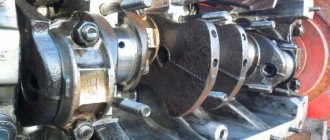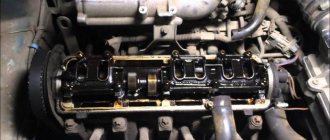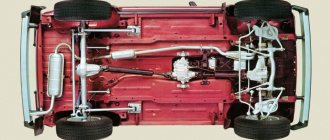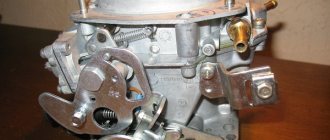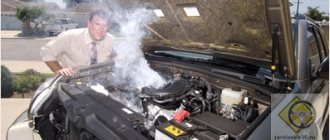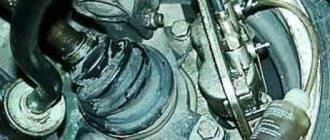The order of the valves of the VAZ 2114
When adjusting, take into account which valve is the inlet and which is the outlet. The procedure is as follows:
5 - exhaust and 2 - inlet;
8 - exhaust and 6 - inlet ; 4 - exhaust and 7 - inlet .
Moving from the camshaft pulley, we measure the gaps between the pusher and the camshaft. In places where the gap corresponds to the norm, we leave everything unchanged. At the place where a probe of the appropriate size is easily pushed into the slot, we press the plate with the device for lowering the pusher and insert a flag to fix the pusher. Then, using special tweezers, we pull out the adjusting washer and look at its markings. If necessary, measure the thickness with a micrometer. Next, we select a thicker washer, put it in its place and first check the gap with the necessary feeler gauge.
Valve clearances
If it doesn’t fit, then take a probe with a smaller thickness, and so on until the probe fits. Based on the difference between the nominal size and the size of the probe, which fits easily, we calculate the required thickness of the adjusting washer. We repeat the procedure until the probe begins to be inserted with slight pinching.
If none of the test probes fit, this means that the valve is overtightened!! According to the above operation, remove the adjusting washer and change it to a smaller size.
What is the correct adjustment of thermal clearances in a car’s gas distribution mechanism or what is affected by valve adjustment. The main advantage is lower fuel consumption (which is important given the ever-increasing price of gasoline). The engine runs quieter and smoother and accelerates faster.
How to determine and why valves are knocking. How often do you need to adjust the valves of VAZ 2114, 2115, what do the manufacturers say? How valves are located in VAZ 2114, 2115 cars. How the clearances are adjusted in VAZ 2114, 2115. Preparing tools. Adjustment of valves.
How to determine and why valves are knocking.
If the valves are not adjusted, characteristic signs appear. The engine operates with a certain noise; a knocking sound is heard on a cold VAZ 2115 engine, similar to a metallic clatter. The reason for this is the gap between the levers and the camshaft cams.
This gap is set by the manufacturer, its value is the same for all engines of the same type. In this vehicle system, the gap increases or decreases, both of which have a bad effect on engine performance and can lead to more serious damage.
Basically, this breakdown occurs due to the use of low-quality fuel. A good fuel is one with an octane number of at least 93.
Interesting fact! There is 100 octane fuel, but it is only used in competitions to fuel racing cars.
How often do you need to adjust the valves of VAZ 2114, 2115, what do the manufacturers say?
Factories and car manufacturers recommend checking thermal clearances every 15-30 thousand kilometers. Even if, in your opinion, the engine is working well, then such a procedure will never be superfluous, especially since you can do it yourself.
How are the valves located in VAZ 2114, 2115 cars.
VAZ 2114 cars are available with an engine with eight or sixteen valves.
Note! Adjustment of the valve clearance of the VAZ 2114 is carried out only for an 8-valve engine, since hydraulic compensators are installed on 16 valves.
The valves in the gas distribution mechanism are designed so that when fuel is injected through one, exhaust gases are released through the other.
How to adjust clearances on VAZ 2114, 2115.
In order for the valve adjustment of the VAZ 2114 injector 8 valves to be effective, it must be done on a cold engine. The gap size on the intake valve should be 0.2 mm, and on the exhaust valve - 0.35 mm.
Note! The permissible error in both cases is 0.05 mm.
Preparing tools.
To adjust the valves of a VAZ 2115 injector 8 valves, we will need the following tools: a set of wrenches for adjusting VAZ valves, a device for valve pusher springs, feeler gauges, a caliper or micrometer, and shims.
Adjustment of valves.
Remove the cylinder head cover.
Remove the air filter and the front timing belt cover.
Unscrew the candles and carefully fold them. They are removed to make it easier to turn the crankshaft.
If on a VAZ-2114
1.5, as it is also called 1.6, the valves “knocked” on eight valves, this indicates that the components need to be adjusted more quickly.
Unfortunately, not all car enthusiasts immediately begin to eliminate such a malfunction, which leads to more severe consequences. After all, if timely adjustment
is not carried out, the engine power will decrease significantly,
the valve
will burn out, and the camshaft may generally become unbalanced.
Don’t understand how to correctly adjust valve clearances on a VAZ- 2114
8 valve? Then we advise you to study the information that will be presented below.
Adjusting the valves without the help of others is easy if you follow the instructions exactly and do the work step by step. Before you check the dimensions of the gap, if they do not correspond to the approved value, and a typical knocking sound is heard when the engine is running, this means that the valves definitely need to be adjusted. To accurately check the size of the gap, you need to wait until the motor has completely cooled.
Video.
When an internal combustion engine operates, the working edges gradually wear out on the valves. Consequently, all valves rise upward over time. It is for this reason that it is necessary to adjust the valves of the VAZ-2114. The design and drive of this car are much more reliable than those of classic series cars.
But still, the frequency of checking the gaps in the valve mechanism is from 15 to 30 thousand kilometers. If you do not check it in time, the thermal gap may decrease, which will lead to engine inoperability. Adjustments also need to be made when replacing VAZ-2114 valves.
The main sources of extraneous sounds in the engine
You must understand that not every extraneous sound is a signal of engine malfunction. This primarily concerns knocking noises in the outer parts of the engine. But everyone has a reason that must be found. For example, the flagellum that holds together the bundle of electrical wires has broken. The wires fell apart and when the engine was running, some of them began to muffledly hit some surface. Will this lead to serious consequences? At first, no. If measures are not taken, then after a long time the insulation on the wire will wear out and a short circuit may occur, which, through the combustion of a fuse, will de-energize some part of the on-board network. Parts that have loose fastening bolts often knock. This is also an unpleasant, but not critical situation. It is enough to take the keys and tighten the loose threaded connections yourself.
Types of extraneous noise in the power unit
Here are the most common extraneous sounds in the engine that should alert the car owner:
Hissing . This specific sound under the hood of the car while the engine is running may indicate air leaks in depressurized vacuum systems or in the cooling system. The consequences can be severe. In the first case, the brake system may fail, in the second, the engine may overheat due to an antifreeze leak. Therefore, you urgently need to go to a car service center to diagnose and eliminate the cause of the hissing sound.
A squealing or sharp whistling sound most likely indicates a weakened drive belt of some component: timing belt, generator, water pump, air conditioning compressor. The belt begins to slip in the drive pulleys and at the same time emit a characteristic squeal. If timely measures are not taken, the belt may break with unpleasant consequences.
Knocks of different tones inside the engine in the area of the crankshaft, pistons, and valves give rise to diagnosing the operation of the engine as a whole to identify the cause of extraneous sounds. Unusual knocking inside the engine is a cause for the most serious concern. Their appearance may signal the possible high costs of eliminating them. If the liner rattles, you will need to disassemble the engine with grooving or even replacing the crankshaft. A knocking sound appeared in the middle of the block - the connecting rod and piston group was worn out. You will need to completely disassemble the engine, bore the cylinder block, change pistons, rings, pins. If the sound is clearly audible in the upper part, then perhaps the valves need to be adjusted, or perhaps the piston reaches the cylinder head due to a large gap in the connecting rod bearings.
Reasons for the appearance of extraneous sounds in the engine
The reasons and circumstances under which knocking appeared are different. Extraneous noise can be clearly heard both outside the engine and inside it. Internal ones are more dangerous than external ones. The cylinder block contains the crankshaft, pistons, connecting rods, and parts of the gas distribution mechanism. If the knocking comes from this group of mechanisms, then this is always associated with partial or complete disassembly of the engine to eliminate the malfunction. Often the sounds are sharp in nature, which intensifies when the throttle is opened smoothly. If the sounds are loud, with a “light tinkling” of iron and appear with a rapid increase in the speed of rotation of the flywheel, then this indicates detonation - a violation of the fuel ignition regime.
Video: Mercedes 126, found the cause of the knocking in the engine
Knocks from detonation
If the knocking is strong with a ringing “metallic” tint and occurs when the gas pedal is sharply pressed, or under load, then this is the result of detonation - explosive combustion of fuel in the cylinders. Moreover, detonation occurs differently in different types of engines. Gasoline engines have the expression “knocking fingers.” This is not entirely correct. In fact, during abnormal fuel combustion, the piston skirt knocks when it passes top dead center. Gasoline detonation is the result of refueling with poor fuel with a low octane rating, incorrect valve timing adjustment, and prolonged engine operation in an overheated state. To eliminate detonation, it is enough to cool the engine, adjust the fuel injection and ignition systems, and fill the tank with gasoline in accordance with the technical regulations of the car.
Diesels also have fuel detonation, but their reason for its formation is different. This is an early injection of diesel fuel or a lean fuel mixture, which arises from improper operation of the pressure valve in the high-pressure fuel pump (HPF). Moreover, the sound will be loud, ringing, similar to the blows of a piston on the surface of the cylinder head. In such cases, they say that the diesel engine operates “hard”. This impression arises because the compression ratio of diesel engines is much higher than that of gasoline engines, so in normal operating condition the distance between the piston and the block head is microscopic. You can get rid of detonation by restoring the operation of the pressure valve on a special stand in a service station.
Even in diesel engines, at idle speed, the knocking of the plungers is clearly audible. This is a design feature of almost all engines of this type. These sounds do not pose any threat. Diesel engines have been used with them for more than one year. In engines with gasoline injection, an experienced ear hears the “clicks” of fuel injectors, which are also inherent in most engines of this type. They do not pose any serious threat to the engine, and in no way affect its performance characteristics.
Valve mechanism knocks
If the valve bushings and hydraulic compensators are worn out, the gaps between the ends of the valves and pushers have increased - ringing, clear sounds will be clearly audible in the area of the cylinder head. It's not difficult to get rid of this. It is necessary to change worn parts and dirty engine oil. Rinse and clean all channels and valve mechanism parts from dirty deposits and adjust the thermal clearances in the valves. This work is specific, requiring special equipment, cleaning agents, and tools. Therefore, it is performed at technical inspection stations. First of all, this applies to cars of domestic and foreign production that are under warranty.
Why else might the engine knock?
Knocks in the engine compartment can occur due to breakdowns of attachments: timing drive, pump, generator, power steering, other pulleys, etc. In diesel engines, you may encounter knocking noise from injection pump plunger pairs.
Very often, a cold start knock may be accompanied by a metallic knock, which occurs as a result of problems with the timing chain tensioner. It should not be ruled out that knocking may occur on some external part that is loosely tightened or the fastening of the element is loose.
Failure of pushers
Another reason for valve knocking “when cold” is wear of the pusher. If the tappets are dirty or leaking, the tappets may be the main cause of insufficient oil flow to the valves. As a result, while the engine is warming up, you can hear a confirming metallic clatter.
If the oil pressure is normal, it is necessary to check the size of the gaps; it is possible that the valves need to be adjusted. The gaps are adjusted using special feelers that establish a gap between the rocker arm and the upper edge of the rod. In the case of an overhead camshaft - between the cam and the pusher. If the gaps are normal, then there may be another reason for the knocking of a cold engine. More on this below.
Compensator design faults
- knocking of compensators can be caused by wear of the striking pad of the plunger pair. This occurs because the camshaft lobes make indentations on the plunger's seat over time;
- defects in individual elements of the compensator may be caused by a factory factor;
- the valve that supplies oil becomes clogged and it can stick;
- air has entered the compensator - as a result of limited oil flow into the mechanism;
- parts of the hydraulic compensator become dirty. This happens due to the gradual sooting of the oil, and when inorganic impurities get into it.
Engine. Oil related systems
- air in the oil (if its level in the engine deviates from the norm);
- carbon deposits and dirt in the oil channels that deliver oil to the hydraulic compensator;
- oil filter malfunction;
- the oil is not selected correctly;
- the engine has overheated (the composition of the engine oil has changed).
Is knocking on a cold engine dangerous? Does knocking occur when the engine is not warmed up? – this is not always critical. The bottom line is that in a warm engine the oil will have a different viscosity, because as it heats up it changes. Due to the fact that oil cannot seep inside the compensator, knocking noise occurs. Diagnostics: which hydraulic compensator is knocking? An experienced locksmith can easily determine the location of the knock. Basically, they use acoustic diagnostics - they accurately determine which hydraulic compensator is tapping. When a knocking element is detected, you need to remove it and wash it. Then put it back and start the engine again. If everything is still knocking, the compensator needs to be replaced. If there is a knock even after replacement, then you need to look for the cause in the engine - in its other parts, and also evaluate the quality of the oil.
Valve knocking on a hot engine: causes, repairs, consequences
Hello, dear friends! I propose to discuss with me today such a topic as valve knocking on a hot engine. You probably know what a timing belt is, what this abbreviation means and what purposes the gas distribution mechanism serves.
One of the key components of the timing belt is the valve. In addition to valves, the assembly contains pushers, hydraulic compensators, rocker arms, hoses, etc. Also, do not forget about the camshaft, or simply camshaft. It is he who is responsible for ensuring that each of the timing elements works correctly.
The essence of the mechanism is that the shaft rotates and actively interacts with its cams with the pushers. The latter rises along with the so-called barbell. The upper edge of the rod acts by pressing on the rocker arm. It, in turn, as it rotates, opens groups of intake and exhaust valves located in the cylinder head.
At the same time, in a car or motorcycle, motorists may notice how the valves begin to knock on a warm and hot engine. You need to know the possible causes and further actions on the part of the car owner.
